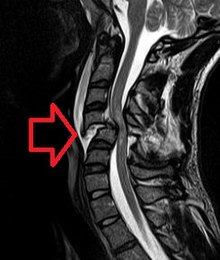
Back صدمة عصبية Arabic Nerwné rëszenié CSB Shock neurogeno Italian Neurogene shock Dutch ସ୍ନାୟୁଜନିତ ଝଟକା OR Wstrząs neurogenny Polish Нейрогенный шок Russian Neurogeni šok Serbo-Croatian Неурогени шок Serbian ภาวะช็อกทางระบบประสาท Thai
| Neurogenic shock | |
|---|---|
 | |
| Cervical spine MRI of a patient with SCI: C4 fracture and dislocation, spinal cord compression | |
| Specialty | Neurology |
Neurogenic shock is a distributive type of shock resulting in hypotension (low blood pressure), often with bradycardia (slowed heart rate), caused by disruption of autonomic nervous system pathways.[1] It can occur after damage to the central nervous system, such as spinal cord injury and traumatic brain injury. Low blood pressure occurs due to decreased systemic vascular resistance resulting from loss of sympathetic tone, which in turn causes blood pooling within the extremities rather than being available to circulate throughout the body. The slowed heart rate results from a vagal response unopposed by a sympathetic nervous system (SNS) response.[2] Such cardiovascular instability is exacerbated by hypoxia, or treatment with endotracheal or endobronchial suction used to prevent pulmonary aspiration.[3]
Neurogenic shock is a potentially devastating complication, leading to organ dysfunction and death if not promptly recognized and treated.[2]
It is not to be confused with spinal shock, which is not circulatory in nature.[2]
- ^ Guly, H.R.; Bouamra, O.; Lecky, F.E. (January 2008). "The incidence of neurogenic shock in patients with isolated spinal cord injury in the emergency department" (PDF). Resuscitation. 76 (1): 57–62. doi:10.1016/j.resuscitation.2007.06.008. PMID 17688997. Retrieved 11 May 2021.
- ^ a b c American College of Surgeons; Committee on Trauma (2018). "Spine and spinal cord trauma". ATLS® - Advanced Trauma Life Support: Student Course Manual (Tenth ed.). Chicago. pp. 129–146. ISBN 9780996826235.
{{cite book}}: CS1 maint: location missing publisher (link) - ^ J.M. Piepmeyer, K.B. Lehmann and J.G. Lane, Cardiovascular instability following acute cervical spine trauma, Cent Nerv Syst Trauma 2 (1985), pp. 153–159.
© MMXXIII Rich X Search. We shall prevail. All rights reserved. Rich X Search